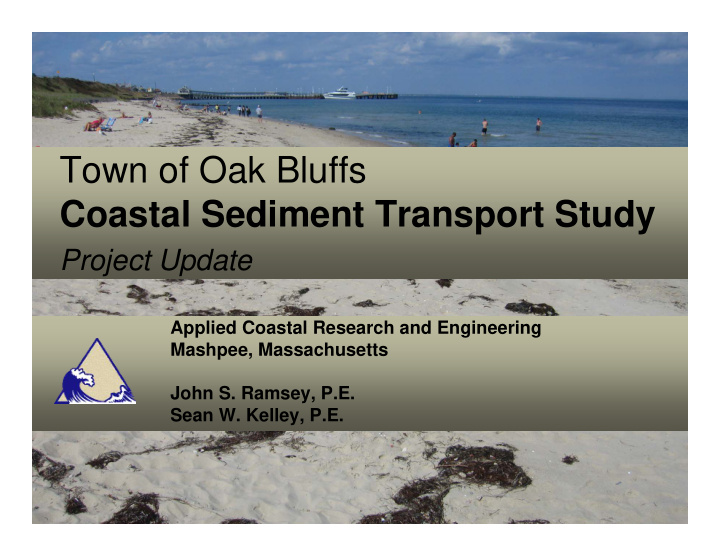



Town of Oak Bluffs Coastal Sediment Transport Study Project Update Applied Coastal Research and Engineering Mashpee, Massachusetts John S. Ramsey, P.E. Sean W. Kelley, P.E.
Bathymetric and Shoreline Change Analyses • Bathymetric change based on CLE 2008 survey and 2000 LIDAR • Shoreline analysis uses data from historical T-sheets, aerial photography, and 2009 GPS survey
Bathymetric Change Analysis • Small-scale beach and nearshore erosion • Results also may show seasonal shifts in beach shape
Shoreline Change 1846 to 2005
Shoreline Change1846 to 2005
Shoreline Change 1846 to 2005
Shoreline Change 1955 to 2005
Shoreline Change 2003 to 2009
Coastal Model Development • Bathymetry from NOAA (GEODAS database supplemented with chart data) and CLE • Open ocean waves from USACE WIS database • Wind data from CMAN platform in Buzzards Bay, 1985 through 2008
Coastal Processes Modeling Wave model of Nantucket sound used to determine wave climate along the Oak Bluffs Shoreline
Coastal Processes Modeling • Local grid with 5-meter grid resolution nested within Nantucket Sound regional model • Local wave model includes – CLE 2008 topography and bathymetry – Harbor Jetties, Steamship Pier, and Groin at Pay Beach
Sediment Transport Potential Modeling • Transport potential along study area is typically ~10,000 cubic yards per year • Actual transport is less due to sediment starved condition of the shoreline and groins
Potential Shoreline Protection Options
Potential Shoreline Protection Options Historical Shore Protection USGS 1941
Potential Shoreline Protection Options Historical Shore Protection U.S. Army Corps 1965 Report
Example 1: Inkwell Beach • 50 ft-wide nourishment • 8,000 cubic yards • Fill lasts longer with rehabilitated groin
Example 2: 2300 ft Nourishment • 50 ft-wide nourishment • 70,000 cubic yards • Rehabilitation of 4 groins • Added protection to base of revetment
Environmental Concerns • Eelgrass beds 250 ft to 300 ft offshore • Regulatory agencies have recently allowed permanent impacts to eelgrass in Woods Hole (direct dredging of the resource)
Environmental Concerns • Example of recently permitted hydraulic placement of sand within ~150 ft of existing eelgrass bed Figure: courtesy of Leslie Fields
Beach Nourishment as a Shore Protection Option • Dead Neck (Barnstable) nourished since 1985 • Most recent large-scale nourishment in 1999 Pre-1999
Beach Nourishment as a Shore Protection Option • ~200,000 cubic yards placed in 1999 • In 2009, approximately 50% remains 1999
Summary • Sediment-starved shoreline • History of “hard” shoreline armoring • Long-term shoreline management using combination of beach nourishment and structures • Possible “structure trading” as a regional approach • Environmental concerns are manageable • Long-term sediment sources…
Recommend
More recommend